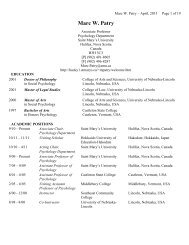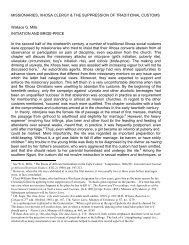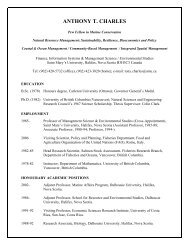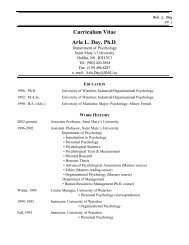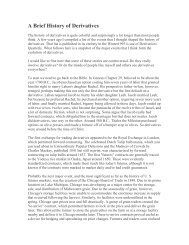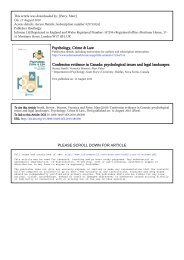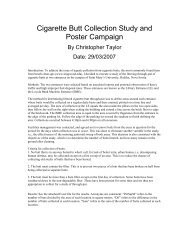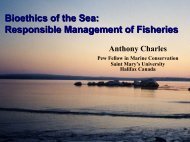Community Fisheries Management Handbook - Saint Mary's University
Community Fisheries Management Handbook - Saint Mary's University
Community Fisheries Management Handbook - Saint Mary's University
You also want an ePaper? Increase the reach of your titles
YUMPU automatically turns print PDFs into web optimized ePapers that Google loves.
Participating in research is a good way to build relationships between<br />
fish harvesters and scientists, managers and regulatory agencies. Harvesters<br />
can consider inviting these potential supporters to assist them in their<br />
activities.<br />
HOW TO DO IT<br />
The research process starts with people asking questions, then developing<br />
a plan to find explanations and answers. Like almost everything else in<br />
community-based management, people talking together and asking themselves<br />
“why?”, “how?” and “what if?” questions is the basis of good participatory<br />
research.<br />
The rest of this chapter reviews some important elements of the research<br />
process.<br />
Developing a<br />
Research Plan<br />
WHAT IS A RESEACH PLAN?<br />
A research plan outlines research priorities and how they will be addressed.<br />
It lists specific research projects and identifies by whom, how, and when<br />
they will be completed.<br />
WHY IS IT IMPORTANT?<br />
A research plan helps in allocating resources to research and in identifying<br />
gaps, such as lack of funds or lack of trained people, which need to be<br />
filled before research can begin.<br />
A research plan makes sure that research is not forgotten in the midst of<br />
the ongoing demands on an organization’s time and resources.<br />
A research plan is a roadmap for action; without clearly focused research<br />
priorities, an organization can get involved with too many research projects<br />
and/or ones that might not strengthen community-based management<br />
efforts and may never be completed.<br />
HOW TO DEVELOP A RESEARCH PLAN<br />
1) Figure out what you need to know. The first step in developing a research<br />
plan is to figure out what the organization really wants to know.<br />
Some questions to ask include:<br />
What information do we need to manage our fisheries?<br />
Why do we want to know this?<br />
What do we already know about this topic?<br />
The answers to these questions will likely produce a long list of potential<br />
research topics. These are the basic building blocks of a research plan that<br />
help in identifying research priorities to meet the organizations’ immediate<br />
and long term needs.<br />
2) Divide research needs into categories. It is easier to identify specific<br />
research priorities when a list of research topics is divided into research<br />
categories. Some examples of categories of research include:<br />
Biological or scientific (e.g. the status of fish stocks and their distribution)<br />
Marketing and economic (e.g. the community economic value of local<br />
fishing activity)<br />
Policy research (e.g. alternatives to current management approach)<br />
Local knowledge studies (e.g. local spawning ground identification)<br />
Many organizations do a research plan as part of their overall fisheries<br />
management plan (Chapter. 3 – <strong>Fisheries</strong> <strong>Management</strong> Planning) with<br />
research being one element of the larger plan. The types of research are<br />
then matched to the different management goals they are to support. For<br />
example:<br />
information about groundfish catch limits can support a goal to develop<br />
an effort-based management alternative.<br />
research into fisheries enforcement in other jurisdictions can support a<br />
goal of setting up a local infractions committee.<br />
PA RT T WO - C H A P T E R F I V E - R E S E A R C H<br />
PAG E 6 9



